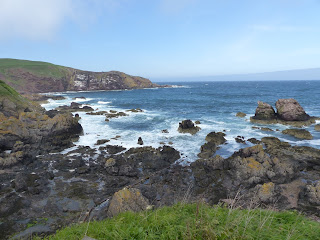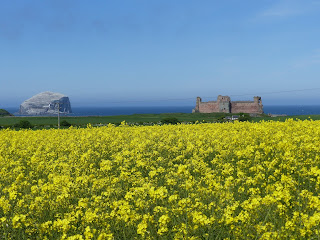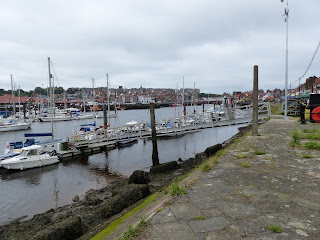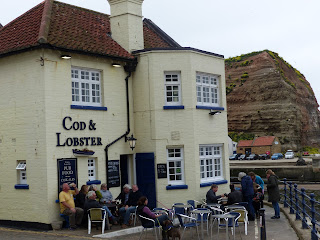DAY 9
Tuesday May 31st
2016
Holy Island
to Dunfermline Miles
108
Today we entered another country – twice! Weather went from cloudy to spectacular,
better than Jim’s home in Norfolk where his wife said that they had received 1½
inches of rain overnight!
Berwick on Tweed was our first destination after leaving Holy
Island. This is the last town in England before you enter Scotland. Ownership moved about eleven times between
Scotland and England, through war and by gift.
However when James I of England (and VI of Scotland) came to the throne
after the death of Elizabeth I, the two countries were united under one crown
and Berwick remained in England.
Albeit it was cloudy most of the time we were there, it was
still presented as a magnificent town. It has the oldest intact defensive walls
still in existence in England. They are
just over 1 mile long and cover ¾ of the town.
They are mainly high stone and mud bankings with some stone built gun
emplacements. We had a bracing walk on
top of them. They started to be built
under Bloody Queen Mary and then continued under Queen Elizabeth and were
reputedly the most expensive thing that was built during her reign. Total cost over 12 years was £137,000 about
£40 million in
today’s money. Elizabeth was almost
bankrupted over this.
We found the people to be extremely friendly and helpful. They are so welcoming that parking in the
town is free of charge, though you do need to purchase a parking disc for $1. This
allows you to park anywhere for up to three hours and lasts for a year. The only surprise was that you had to pay 20
pence to use the loo. We heard yesterday
on the BBC that the majority of towns in England are now getting rid of their
public toilets altogether. Apparently as
Tescos (and other supermarkets) have them, Councils have decided to save money.
Thank goodness for Tesco.
At one place on the walls we looked down on probably the neatest
allotments in Britain. All the plots
looked beautifully planted or dug in preparation for planting. The soil is black and rich, almost like
peat. Not a weed in sight. From one allotment hut we could hear Mozart
being played. Clearly the gardeners in
Berwick have sophisticated tastes!
After a cup of hot chocolate we both decided that our hair was
getting too long and looked for a hairdresser.
The first was full up, the second closed and the third could only take
one of us. As there was a guitar shop
close by, Jim opted to forgo his haircut and play with the guitars. I did get mine cut and am now feeling very
tidy.
After Berwick we set off for Eyemouth, over the border into
Scotland. Just before arriving in this
little fishing village, horror struck.
On deciding to text my wife I discovered that I had left my mobile phone
back at the Lindisfarne Hotel. I could
not continue my journey without a cell phone, so had to make the painful
decision to return and get it. It meant
an extra 30 mile round trip and about 45 minutes added to our journey. Anita at the hotel (who called me “Pet”) had
found it and returned it to me. She had
also, earlier, told me of places that I must visit when I get to the Orkneys,
so Anita thank you for not only saving my trip but also adding to it with good
advice.
Returning to Eyemouth we crossed into Scotland for the second
time within the space of an hour.
Eyemouth is a bustling place with an active fishing industry as
evidenced by the trucks departing with fresh fish. As we left the town we found ourselves behind
a funeral cortege with lots of people walking behind the coffin and on to the
graveside. We did not know who the
deceased was, but he or she was clearly well liked and respected as borne out
by the number of people who were present.
St Abbs Head and village was our next destination and what a
wonderful little place this is. There is
a steep road down into the little harbour, which can only be described as
charming. The sea was blue but the surf
was up and the waves were crashing over the rocks. There is a poignant memorial on the point
overlooking the village remembering 3 fishermen from St Abbs who perished in a
great storm in March 1881, which claimed in one night, a total of 189 fishermen
from along the Scottish east coast. We
cooked up on my little stove a lunch of pea and ham soup, which was sufficient
for the rest of the day (only needing to be topped up by a bag of jelly babies
from the RNLI shop in Dunbar!).
The whole of the east coast of Scotland is dramatic and
beautiful. The sun shone brightly and
the sea remained blue all the way towards Edinburgh. The roadsides still had gorse in bloom but
the hawthorn, unlike further south, was only just beginning to blossom. We felt that Scotland was about 3 weeks later
in blooming than the south of England.
The A1107 towards Cocksburnspath is wind turbine alley with rows
and rows of blades spinning gracefully.
I wonder if in 100 years time these turbines will be as revered as much
as the windmills of 100 years ago are today.
Dunbar is a fine town and the start of the Golf Course Coast and
has excellent sandy beaches. Here we
visited the RNLI shop. The RNLI do such
a great job. It is striking just how
many RNLI stations there are. Almost
every bay and village and of course the towns I have passed through, have an
RNLI station with boats large and small.
Every vessel is manned by volunteers and the RNLI is funded only by
donations. There are many sailors alive
to day who have to give thanks to the RNLI for their rescue. Tragically there are also many lifeboat men
who have lost their lives trying to save mariners.
At North Berwick we stopped to photograph Bass rock and
Tantallon Castle, which looked magnificent across a field of oilseed rape and
in the blue water. Again another lovely
town. It does seem that Scottish towns
have an air of solidity, orderliness and perhaps also a certain somberness. They are generally smart and without an over
abundance of awful garish high street signs that we have seen on our journey
through England.
We drove through Muirfield Golf Course where a US Boys golf
tournament was taking place. Muirfield
has recently been in the news for having been denied the opportunity to host
the British Open because it does not allow women as members. In my experience golf clubs are all about
keeping people out rather than encouraging people to join. I am stunned that they can even continue to
take this stance and I hope that the “loss” of potential income and prestige
they will incur for not hosting the Open is at least a kick to their snobbish backsides
and that changes happen soon. I was particulalry
shocked to hear Peter Allis, the main TV commentator for golf tournaments say,
that “If women want to play at Muirfield all they have to do is marry a member”. I am glad that my hobby is not golf and that
I don’t have to mix with such people.
One other annoyance was that Murifield is allowed to put up temporary
traffic lights to allow the golfers to cross the road. These are “golfer controlled”. I certainly am all for road safety, but to be
able to hold up main road traffic to allow some arrogant people to chase a
little white ball is crazy. (How many
points for running over a golfer?).
We entered Edinburgh at Musselburgh and continued on to Leith to
try and get to see the Royal Yacht Britannia before it closed to visitors. We were too late but did manage to get some
pictures through windows from within the magnificent shopping mall that is built
alongside. The Royal Yacht has certainly
dramatically changed Leith from poor and run down docklands to a very upmarket
place to be.
We then fought the Edinburgh homebound traffic through to the
Forth Road Bridge. This was very
congested but in 2016 a new bridge will open right alongside it. The construction of this is tremendous and it
will be a work of art when it is completed.
It will come close, but not surpass, the original Forth rail bridge
which still stands as an icon for Edinburgh and British engineering. The old necessity of having to constantly
keep painting the bridge (“when you get to one end you go back to the beginning
and start again”) is now no longer true.
Modern paints allow them a 5 year break before repainting is necessary.
The original rail bridge took over from the centuries old ferry that
ran from Queens Ferry across the Firth of Forth. The ferry had its origins right back to the
time of Queen Margaret (later a Saint of Scotland) who had supported the
building of a Benedictine Abbey at Dunfermline and then paid for a ferry to be
put in place to allow pilgrims to travel there from Edinburgh. Margaret’s family had fled from England to
the Continent when William the Conqueror invaded. She was the niece of Edward the Confessor. She later came to Scotland and married King
Malcolm III (who had deposed my ancestor King Macbeth). She had 8 children by him. Three of her sons became Kings of Scotland
and one daughter married Henry 1 of England.
She died in 1083, three days after Malcolm and her eldest son were
killed in battle. One strange but
interesting fact about Margaret is that in 1560, Mary Queen of Scots, ordered
the opening of Margaret’s tomb and the removal of her head, which was brought
to her in Edinburgh to provide saintly protection for her during childbirth.
The head was passed to the Jesuits in Douai in France, but lost during the
French Revolution. Her remaining bones
were removed by Philip II of Spain and moved to Escorial, but have also since
been lost.
Unfortunately Samantha got confused by all of the construction
at the end of the bridge, where new roads will soon merge. Trying to be nice to her today and follow her
instructions we got hopelessly lost for about 5 minutes, but we can't blame her
as the road works have not yet been “charted”.
Jim and I spent the evening with two of my cousins, who greeted
us with waving flags when we arrived – just like royalty. A good meal, lots of chat and an 8 week old
kitten to play with ended a fine day’s driving.
Tomorrow Jim departs back to Norfolk and I continue on on my own
towards Aberdeen. I will once again have
to get used to my own company.




























